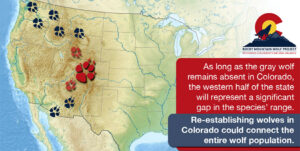🙋♀️ #wolfdoguk #officialwolfdog #wolf
On Tuesday, Nov. 3, voters in Colorado were asked whether they supported a ballot initiative to reintroduce wolves to the western part of the state.
That measure passed, and wolves will be reintroduced. So what does that look like? What happens next? Here’s what we know.
With the “yes” vote from Tuesday, Nov. 3, the Colorado Parks and Wildlife Commission will need to create a plan to reintroduce wolves to the western part of the state by the end of 2023.
What is the history of gray wolves in Colorado?
Wolves are native to Colorado, but were eradicated from the landscape by the mid-1940s. Hunters and ranchers shot, trapped and poisoned wolves.
Are there wolves already in Colorado?
Yes, it does look like there are, periodically, wolves in the state. Colorado Parks and Wildlife says it fields about 100 wolf sightings every year. Sightings were made in 2020, including this sighting of a pup by a biologist in June. Shortly before the pup sighting, the biologist saw an adult gray wolf. The sighting could mean wolves were breeding in the state, but there is no evidence to support that.
Also, in January of 2020, a group of six wolves were confirmed in Moffat County in northwest Colorado.
Where will wolves be reintroduced at?
The ballot initiative states that wolves will be relocated west of the continental divide in Colorado. Basically, that means the Rocky Mountains and west into what is called the Western Slope of Colorado.
Colorado Parks and Wildlife must put a plan together that:
Uses the best scientific data available;
Includes input and information from statewide public hearings;
Includes scientific, economic and social considerations;
Pays fair compensation to owners of livestock for any losses caused by gray wolves; and
Assists owners of livestock in preventing and resolving conflicts between wolves and livestock.
Who pays for this reintroduction?
Taxpayers will fund it. According to CPW:
“Costs for the development and implementation of the management plan and reintroduction, and for fair compensation for livestock losses as called for in the ballot initiative are to be borne by CPW’s wildlife cash fund (hunting- and fishing-derived revenue), unless the wildlife cash fund cannot pay for such expenses.
There will be funding and staffing impacts to CPW, should a reintroduction occur. A more precise understanding of what this would look like will be apparent after a management plan is developed.”
How much will this cost?
It is estimated that the initiative will cost $344,363 in 2021-22 and $467,387 in 2022-23.
When will wolves be reintroduced?
Colorado Parks and Wildlife must begin reintroductions of gray wolves by Dec. 31, 2023.
 Who would manage the population of wolves in Colorado?
Who would manage the population of wolves in Colorado?
Since gray wolves are scheduled to be removed from the Endangered Species Act in early 2021, Colorado Parks and Wildlife will be responsible for wolf management in the state. Should gray wolves not be removed from the ESA, the United States Fish and Wildlife Service would be the management authority.
What subspecies would be introduced in Colorado?
It’s likely that the Rocky Mountain subspecies would be introduced to Colorado. This subspecies is also referred to as the Northwest subspecies. This subspecies is the largest subspecies of gray wolf.
When wolves were reintroduced to Yellowstone National Park, this is the subspecies that was used. Most of those wolves were captured in Canada and relocated to Yellowstone, leading some critics to question if that was appropriate. Colorado Parks and Wildlife addressed that issue by saying:
“Some have questioned whether the ‘wrong’ subspecies of wolf was reintroduced into Yellowstone National Park. The National Park Service’s lead wolf biologist says the answer is no. The wolves reintroduced into Yellowstone were somewhat larger than what was believed to have been there historically, though the difference may be within the range of natural variation that could be expected.”
What prey exists for wolves in Colorado?
Colorado has a stable elk population estimated at 287,000. This population would be their main source of prey.
Shared from : https://wolf.org/ at the International Wolf Center.


Last 3 Comments